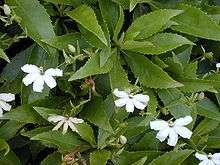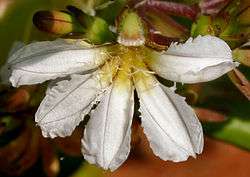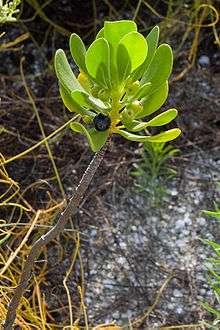Scaevola (plant)
Scaevola is a genus of flowering plants in the Goodenia family, Goodeniaceae. It consists of more than 130 tropical species, with the center of diversity being Australia and Polynesia. There are around 80 species in Australia, occurring throughout the continent. Diversity is highest in the South West, where around 40 species are endemic.
| Scaevola | |
|---|---|
 | |
| Scaevola chamissoniana | |
| Scientific classification | |
| Kingdom: | Plantae |
| Clade: | Tracheophytes |
| Clade: | Angiosperms |
| Clade: | Eudicots |
| Clade: | Asterids |
| Order: | Asterales |
| Family: | Goodeniaceae |
| Genus: | Scaevola L.[1][2] |
| Type species | |
| Lobelia plumieri L.[3] | |
| Species | |
|
About 120, see text | |
| Synonyms[4] | |
Common names for Scaevola species include scaevolas, fan-flowers, half-flowers, and naupaka, the plants' Hawaiian name. The flowers are shaped as if they have been cut in half. Consequently, the generic name means "left-handed" in Latin.[5] Many Hawaiian legends have been told to explain the formation of the shape of the flowers. In one version a woman tears the flower in half after a quarrel with her lover. The gods, angered, turn all naupaka flowers into half flowers and the two lovers remained separated while the man is destined to search in vain for another whole flower.[6]

Scaevola is the only Goodeniaceae genus that is widespread outside of Australia. In at least six separate dispersals, about 40 species have spread throughout the Pacific Basin, with a few reaching the tropical coasts of the Atlantic and Indian Oceans.
The Hawaiian Islands are home to ten Scaevola species, nine of which are endemic.[7] Eight of the indigenous species are the result of a single colonization event. Scaevola glabra and Scaevola taccada arrived separately to produce a total of three colonizations of Hawaii by Scaevola. Some of the endemic species are of hybrid origin.[8]
Beach naupaka (Scaevola taccada synonym S. sericea) occurs throughout the Pacific and Indian Oceans and is considered an invasive species in Florida, USA, and in some islands of the Caribbean including the Cayman Islands[9] and the Bahamas. Beachberry or Inkberry (Scaevola plumieri) is widespread along the Atlantic coast of the tropical Americas and Africa; however, it is becoming rarer in areas where S. taccada is displacing native coastal plants.
Most Australian Scaevola have dry fruits and sprawling, herbaceous to shrubby habits. By contrast, nearly all species outside Australia have shrub habits with fleshy fruit making dispersal by frugivores easy.
The plant pathogenic sac fungus Mycosphaerella scaevolae was discovered on a Scaevola fan-flower.
Taxonomy
The genus Scaevola was first described by Carl Linnaeus in 1771.[1] He did not explain the origin of the genus name.[10] It is considered to allude to the one-sided shape of the flower, which has a five-lobed tubular corolla; scaevus in Latin means 'left-handed'.[5] Linnaeus created the genus for a species he had previously described as Lobelia plumieri, which is thus the type species. Linnaeus did not explicitly use the specific epithet plumieri in combination with the genus Scaevola; the combination Scaevola plumieri was first published by Martin Vahl in 1791.[11]
Species

As of January 2020, Plants of the World Online accepted the following species:[12]
- Scaevola acacioides Carolin
- Scaevola aemula R.Br.
- Scaevola albida (Sm.) Druce
- Scaevola amblyanthera F.Muell.
- Scaevola anchusifolia Benth.
- Scaevola angulata R.Br.
- Scaevola angustata Carolin
- Scaevola archeriana L.W.Sage
- Scaevola arenaria E.Pritz.
- Scaevola argentea Carolin
- Scaevola auriculata Benth.
- Scaevola balansae Guillaumin
- Scaevola ballajupensis L.W.Sage
- Scaevola barrierei A.S.Wulff & Munzinger
- Scaevola basedowii Carolin
- Scaevola beckii Zahlbr.
- Scaevola brookeana F.Muell.
- Scaevola browniana Carolin
- Scaevola bursariifolia J.M.Black
- Scaevola calendulacea (Andrews) Druce
- Scaevola calliptera Benth.
- Scaevola canescens Benth.
- Scaevola × cerasifolia Skottsb.
- Scaevola chamissoniana Gaudich.
- Scaevola chanii K.M.Wong
- Scaevola chrysopogon Carolin
- Scaevola coccinea Däniker
- Scaevola collaris F.Muell.
- Scaevola collina J.M.Black ex E.L.Robertson
- Scaevola coriacea Nutt.
- Scaevola crassifolia Labill.
- Scaevola cuneiformis Labill.
- Scaevola cunninghamii DC.
- Scaevola cylindrica Schltr. & K.Krause
- Scaevola densifolia Carolin
- Scaevola depauperata R.Br.
- Scaevola enantophylla F.Muell.
- Scaevola eneabba Carolin
- Scaevola erosa Guillaumin
- Scaevola floribunda A.Gray
- Scaevola gaudichaudiana Cham.
- Scaevola gaudichaudii Hook. & Arn.
- Scaevola glabra Hook. & Arn.
- Scaevola glabrata Carolin
- Scaevola glandulifera DC.
- Scaevola globosa (Carolin) Carolin
- Scaevola globulifera Labill.
- Scaevola glutinosa Carolin
- Scaevola gracilis Hook.f.
- Scaevola graminea Ewart & A.H.K.Petrie
- Scaevola hainanensis Hance
- Scaevola hamiltonii K.Krause
- Scaevola hobdyi W.L.Wagner
- Scaevola hookeri F.Muell. ex Hook.f.
- Scaevola humifusa de Vriese
- Scaevola humilis R.Br.
- Scaevola kallophylla G.J.Howell
- Scaevola kilaueae O.Deg.
- Scaevola laciniata F.M.Bailey
- Scaevola lanceolata Benth.
- Scaevola linearis R.Br.
- Scaevola longifolia de Vriese
- Scaevola macrophylla (de Vriese) Benth.
- Scaevola macropyrena I.H.Müll.
- Scaevola macrostachya Benth.
- Scaevola marquesensis F.Br.
- Scaevola micrantha C.Presl
- Scaevola microcarpa Cav.
- Scaevola microphylla Benth.
- Scaevola mollis Hook. & Arn.
- Scaevola montana Labill.
- Scaevola muluensis K.M.Wong
- Scaevola myrtifolia (de Vriese) K.Krause
- Scaevola neoebudica Guillaumin
- Scaevola nitida R.Br.
- Scaevola nubigena Lauterb.
- Scaevola obovata Carolin
- Scaevola oldfieldii F.Muell.
- Scaevola oppositifolia Roxb.
- Scaevola ovalifolia R.Br.
- Scaevola oxyclona F.Muell.
- Scaevola paludosa R.Br.
- Scaevola parvibarbata Carolin
- Scaevola parviflora K.Krause
- Scaevola parvifolia F.Muell. ex Benth.
- Scaevola pauciflora Leenh.
- Scaevola paulayi Fosberg
- Scaevola phlebopetala F.Muell.
- Scaevola pilosa Benth.
- Scaevola platyphylla Lindl.
- Scaevola plumieri (L.) Vahl
- Scaevola porocarya F.Muell.
- Scaevola porrecta A.C.Sm.
- Scaevola procera Hillebr.
- Scaevola pulchella Carolin
- Scaevola pulvinaris K.Krause
- Scaevola racemigera Däniker
- Scaevola ramosissima (Sm.) K.Krause
- Scaevola repens de Vriese
- Scaevola restiacea Benth.
- Scaevola revoluta R.Br.
- Scaevola sericophylla F.Muell. ex Benth.
- Scaevola socotraensis H.St.John
- Scaevola spicigera Carolin
- Scaevola spinescens R.Br.
- Scaevola striata R.Br.
- Scaevola subcapitata F.Br.
- Scaevola taccada (Gaertn.) Roxb.
- Scaevola tahitensis Carlquist
- Scaevola tenuifolia Carolin
- Scaevola thesioides Benth.
- Scaevola tomentosa Gaudich.
- Scaevola tortuosa Benth.
- Scaevola verticillata Leenh.
- Scaevola virgata Carolin
- Scaevola wrightii (Griseb.) M.Gómez
- Scaevola xanthina K.A.Sheph. & Hislop
Notes
- "Scaevola". The International Plant Names Index. Retrieved 2019-12-15.
- "Scaevola". Australian Plant Name Index (APNI), IBIS database. Centre for Plant Biodiversity Research, Australian Government.
- Carolin, R.C. (2017) Flora of Australian online profile: Scaevola. Retrieved 15 May 2019.
- "Genus: Scaevola L." Germplasm Resources Information Network. United States Department of Agriculture. 2007-10-05. Retrieved 2010-09-21.
- Hyam, R. & Pankhurst, R.J. (1995). Plants and their names : a concise dictionary. Oxford: Oxford University Press. p. 452. ISBN 978-0-19-866189-4.
- Hammer, Roger (Spring 1998). "Postcards from Paradise: Separated Lovers and the Beach Naupaka" (PDF). Wildland Weeds: 7–8.
- "Selected Plants Found on Hawaii's Offshore Islets". Offshore Islet Restoration Committee. Archived from the original on 2009-03-01.
- Howarth, Dianella G.; David A. Baum (2005). "Genealogical evidence of homoploid hybrid speciation in an adaptive radiation of Scaevola (Goodeniaceae) in the Hawaiian Islands". Evolution. 59 (5): 948–961. doi:10.1111/j.0014-3820.2005.tb01034.x. PMID 16136795.
- DaCosta-Cottam, M.; Olynik, J.; Blumenthal, J.; Godbeer, K.D.; Gibb, J.; Bothwell, J.; Burton, F.J.; Bradley, P.E.; Band, A.; Austin, T.; Bush, P.; Johnson, B.J.; Hurlston, L.; Bishop, L.; McCoy, C.; Parsons, G.; Kirkconnell, J.; Halford, S.; Ebanks-Petrie, G. (2009). "Cayman Islands National Biodiversity Action Plan 2009" (PDF). Cayman Islands Government. Department of Environment. Cite journal requires
|journal=(help) - Linnaeus, Carl (1771). "Scaevola". Mantissa Plantarum Altera. Generum editionis VI (in Latin). Stockholm: Holmiae. Retrieved 2019-12-15.
- Jeffrey, C. (1980). "On the nomenclature of the strand Scaevola species (Goodeniaceae)". Kew Bulletin. 34 (3): 537–545. doi:10.2307/4109829. JSTOR 4109829.
- "Scaevola L.". Plants of the World Online. Royal Botanic Gardens, Kew. Retrieved 2019-12-15.
References
- Howarth, Dianella G.; Gustafsson, Mats H.G.; Baum, David A. & Motley, Timothy J. (2003): Phylogenetics of the genus Scaevola (Goodeniaceae): implication for dispersal patterns across the Pacific Basin and colonization of the Hawaiian Islands. Am. J. Bot. 90(6): 915-213. PDF fulltext Supplemental data